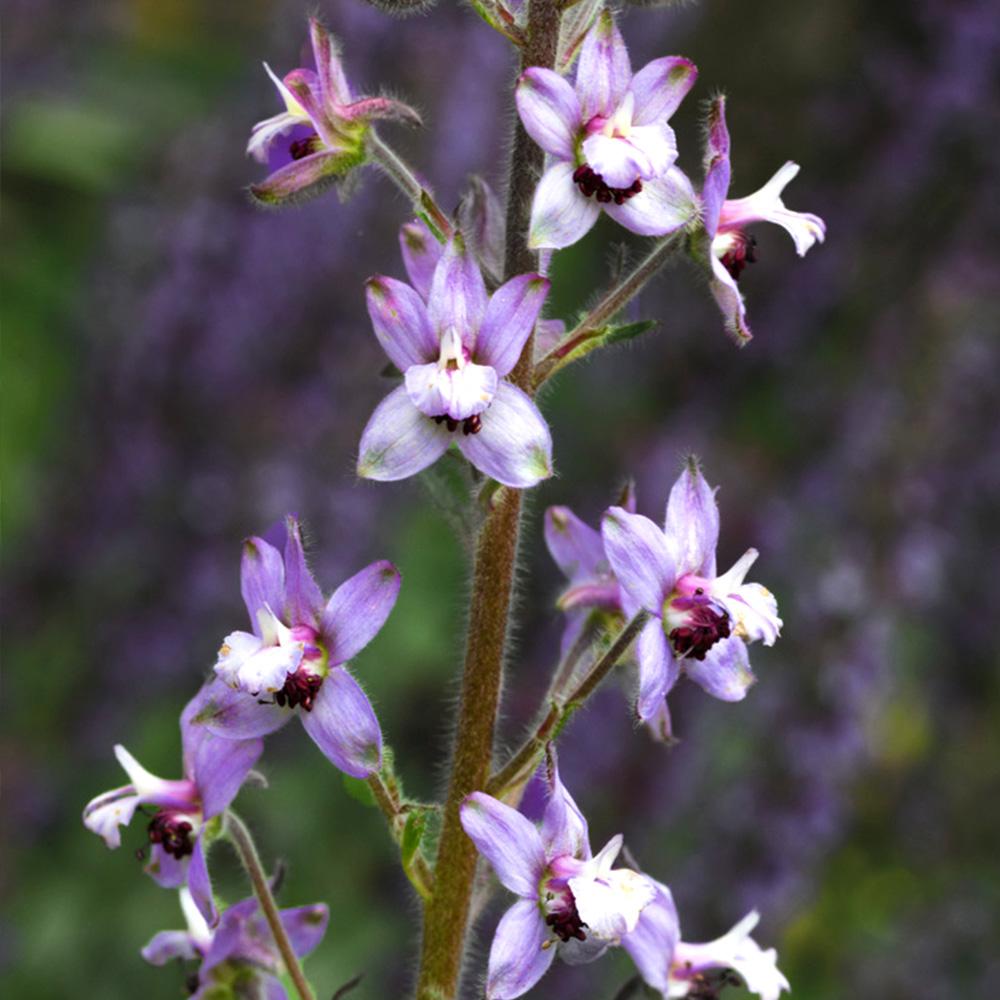No products in the cart.
Delphinium requienii
Lilac-metallic flowers on tall spires
Rated 0 out of 5
0 customer reviews
4,90 €
Only 1 item(s) left in stock!
Tags: perennial, secheresse, soleil, vivace, xeriscaping
SKU: pda414
Category: Bees and Butterflies, Bouquet, Evergreen, Fragrant, Frost Hardy, Rewild

Delphinium requienii
4,90 €
Only 1 item(s) left in stock!
Delphinium requienii is a rare, short-lived perennial that produces lilac-metallic flowers on tall spires.
The flowers are orchid-like, densely packed and wonderfully lilac blue. They have a slight metallic sheen to them so they glisten in the sun.
The leaves are dark green, shiny, marbled and star-shaped.
Unlike many traditional delphiniums, this variety thrives in warmer climates and adapts well to dry, rocky soils.
Its architectural height makes it a striking choice for borders, wildflower meadows, and naturalistic planting schemes.
👨🌾GARDENING TIPS👨🌾:
-
- 💀⚠️ Deliphinium are poisonous plants.💀⚠️
- All parts of all larkspur species are poisonous, but new growth and the seeds contain the highest concentrations of toxic substances
- The method of toxicity has been identified as neuro-muscular paralysis, leading to respiratory failure, bloat and often death.
- Soil preferences: fertile, well-drained but moisture-retentive soil in full sun
- As the flowers are delicate, it is advisable to provide shelter from strong winds and provide stakes or other supports.
- Self-seeds readily
- 💀⚠️ Deliphinium are poisonous plants.💀⚠️
The Tales:
delphis means ‘dolphin’ in Greek – the buds resemble a leaping dolphin if you relax your eyes.
Its common name in english, Larkspur, is a reference to the long tapering spur that can be observed on an un-opened flower buds. It looks a bit like a lark’s spur. A little bit.
The ancient Greeks believed that the flower had magical properties.
In Medieval England, they went further – using the root of the flower to make love potions. How effective was this if the plant was poisonous? Hard to say.
Some say they are willing to die for their love – perhaps the origin of the saying lies with the Deliphinium family.
Other Names:
Requien’s Larkspur
Larkspur
Lark’s Heel
Origin:
Corsica, Sardinia
| Weight | 0,5 kg |
|---|---|
| Flower Color | Lilac, 🔵 Blue |
| Flowering | June, July, August, September |
| Soil | Nutrient-Dense, Rocky/Well-Draining |
| Exposure | Full Sun |
| Frost Tolerance | -10°C to -15°C |
| Size | 1.2m H x 0.6m W |
Reviews
0
Rated 0 out of 5
0 customer reviews
5
0
4
0
3
0
2
0
1
0
Only logged in customers who have purchased this product may leave a review.
Related Products
Hieracium maculatum Leopard
A native perennial with blue-green leaves and a tall yellow flower
A native perennial with blue-green leaves and a tall yellow flower
Rated 0 out of 5
Achillea ptarmica Boule de Neige
White pompom flowers to attract bees to your garden all summer long.
White pompom flowers to attract bees to your garden all summer long.
Rated 0 out of 5
Billbergia nutans
A bromeliad featuring a three colored, striped flower
A bromeliad featuring a three colored, striped flower
Rated 0 out of 5
Cerastium tomentosum var. columnae
A grey-green spreading ground cover from the mountains.
A grey-green spreading ground cover from the mountains.
Rated 0 out of 5
Sedum album
A low, multi-color ground cover.
A low, multi-color ground cover.
Rated 0 out of 5
Artemisia alba subsp camphorata
A highly fragrant, grey-green bush.
A highly fragrant, grey-green bush.
Rated 0 out of 5
Delosperma cooperi
A dwarf perennial known for its vermillion colored flowers
A dwarf perennial known for its vermillion colored flowers
Rated 0 out of 5
Mentha x piperita ‘Chartreuse’
A spicy mint, known for its use in the production of liqueurs and herbal teas.
A spicy mint, known for its use in the production of liqueurs and herbal teas.
Rated 0 out of 5
Solidago ‘Golden Shower’
Beautiful showers of yellow flowers
Beautiful showers of yellow flowers
Rated 0 out of 5
Euphorbia myrsinites
Known for its draping form of silver-gray foliage and radiant blooms.
Known for its draping form of silver-gray foliage and radiant blooms.
Rated 0 out of 5
Artemisia vulgaris Oriental Limelight
Striking green and yellow variegated foliage.
Striking green and yellow variegated foliage.
Rated 0 out of 5
Erigeron kavinskianus
A daisy-like carpet of flowers
A daisy-like carpet of flowers
Rated 0 out of 5
Vinca minor
Looping elegance and ability to form a low flowering ground cover
Looping elegance and ability to form a low flowering ground cover
Rated 0 out of 5
Jacobaea maritima
A wooly white perennial plant from the Mediterranean region.
A wooly white perennial plant from the Mediterranean region.
Rated 0 out of 5
Echinops ritro
Tall, electric blue globe thistles
Tall, electric blue globe thistles
Rated 0 out of 5
Tradescantia Blushing Bride
Gorgeous blushes of pink and white that appear in the coldest nights.
Gorgeous blushes of pink and white that appear in the coldest nights.
Rated 0 out of 5
Glechoma hederacea
A sweet smelling ground cover, producing little blue flowers all summer long.
A sweet smelling ground cover, producing little blue flowers all summer long.
Rated 0 out of 5
Tanacetum densum subsp amani
A shrublet composed of soft, finely divided silvery gray-white leaves.
A shrublet composed of soft, finely divided silvery gray-white leaves.
Rated 0 out of 5
recent view product
Miscanthus sinensis Purpurascens
A color shifting, tall grass from Asia.
A color shifting, tall grass from Asia.
Rated 0 out of 5
Leucanthemum x superbum Brightside
A bushy perennial that produces an explosion of large white flowers
A bushy perennial that produces an explosion of large white flowers
Rated 0 out of 5
Stipa tenuifolia
A species of long, blonde, feathery grass.
A species of long, blonde, feathery grass.
Rated 0 out of 5
Sedum spurium Tricolor
A tricolored mat forming sedum
A tricolored mat forming sedum
Rated 0 out of 5
Chamaemelum nobile
A perennial with bright daisy-like flowers, known for flavoring teas and syrups.
A perennial with bright daisy-like flowers, known for flavoring teas and syrups.
Rated 0 out of 5













































There are no reviews yet.